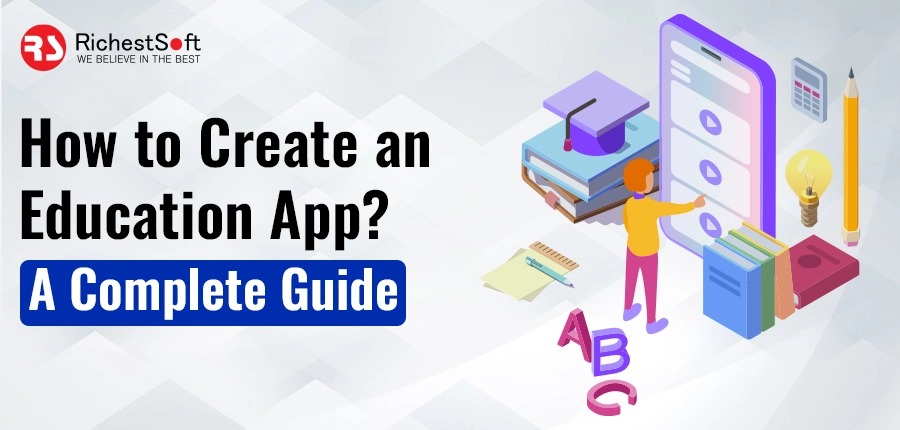Technology has altered how we study and access knowledge in today’s quickly expanding digital generation. Designing mobile educational applications is a decisive breakthrough that has revolutionized the academic field. With the increasing accessibility of smartphones and tablets, educational apps are witnessing a surge in popularity among students, teachers, and parents alike. These apps have become valuable tools for enhancing learning and engaging users in interactive and personalized educational experiences.
According to the latest data, the international education app market is predicted to reach an impressive $350 billion by 2025, with a compound annual growth rate of around 27% (Source: Research and Markets). This exponential climb recalls the growing understanding of the significance and value of educational apps in improving the learning process.
Why are educational apps essential? Their ability to transform traditional learning methods into interactive and engaging experiences is the answer. Educational apps offer numerous benefits, such as personalized learning, accessibility, and flexibility. They allow students to learn independently, reinforcing concepts through interactive exercises and quizzes. These apps also enable educators to track students’ progress and provide tailored feedback, leading to improved academic performance.
Moreover, educational apps bridge the gap between classroom learning and real-world applications. With features like virtual simulations, gamification, and augmented reality, students can grasp complex concepts through immersive and interactive experiences. Educational apps foster active learning by incorporating multimedia elements and interactive content, making education more enjoyable and effective.
This blog post will examine the process of How to Create an Education App and the procedures required. This blog offers a thorough introduction for newcomers, underlining the importance of educational apps in the modern day, whether you’re a teacher, a student, or an entrepreneur engaged in the education market.
Types of Education Apps
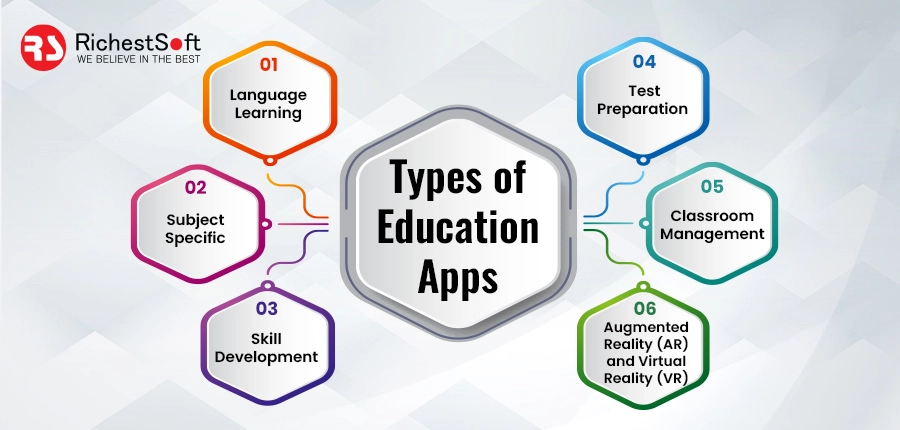
✅Language Learning Apps:
Language learning apps provide interactive and immersive experiences for mastering new languages. With features like vocabulary building, grammar exercises, pronunciation guides, and even real-time conversation practice, these apps make language acquisition enjoyable and accessible.
✅Subject-Specific Apps:
Subject-specific apps enhance knowledge in specific academic disciplines, such as mathematics, science, history, or literature. These apps often offer engaging lessons, interactive quizzes, and in-depth explanations, enabling students to grasp complex concepts in a personalized and interactive manner.
✅Skill Development Apps:
Skill development apps go beyond traditional academic subjects and focus on cultivating essential skills, such as critical thinking, problem-solving, creativity, and digital literacy. These apps often incorporate gamification elements and interactive challenges to make the learning process engaging and enjoyable.
✅Test Preparation Apps:
Test preparation apps are designed to help students prepare for standardized exams or assessments. These apps offer practice questions, mock tests, performance tracking, and detailed explanations to enhance test-taking skills and boost confidence.
✅Classroom Management Apps:
Classroom management apps are designed for educators to streamline administrative tasks, such as attendance tracking, grade management, lesson planning, and communication with students and parents. These apps optimize classroom efficiency, allowing teachers to focus more on instruction.
✅Augmented Reality (AR) and Virtual Reality (VR) Apps:
AR and VR apps leverage immersive technologies to create simulated environments that enhance learning experiences. From virtual field trips to interactive 3D models, these apps provide a unique and engaging way to explore complex concepts and stimulate curiosity.
Understanding the Target Audience
The first step in developing an educational app is comprehending the target audience profoundly. Who are the primary users of your educational app? Consider age, educational background, learning preferences, and goals. Knowing your target audience, you can design an app that caters to their needs and ensures an engaging and personalized learning experience.
Defining Clear Objectives
Defining clear objectives is essential to steer your Education app development process in the right direction. What do you want to achieve with your Education app? Is it to enhance specific skills, provide supplementary learning materials, or facilitate collaborative learning? Defining your objectives helps you stay focused and ensures your app meets the desired learning outcomes.
Technology Used in Education App Development
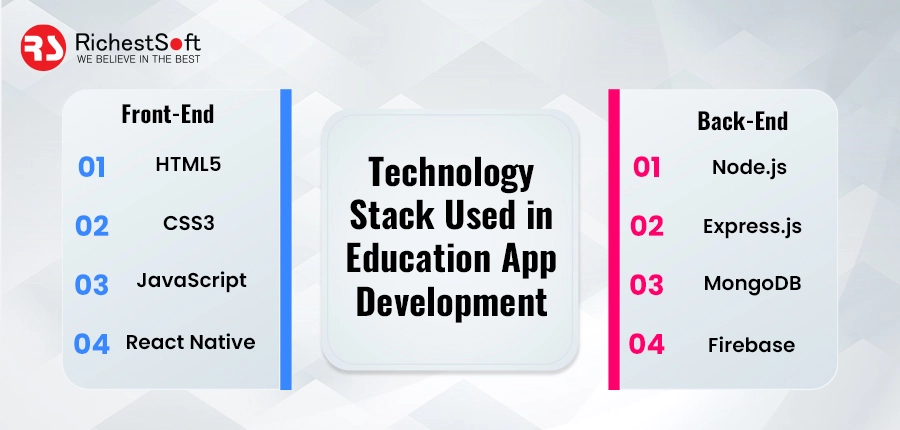
Learning is now more approachable, participatory, and enjoyable due to the development of educational applications. Here, we will explore how technology and development play a crucial role in creating innovative education apps that cater to the evolving needs of learners
Technology Stack:
Selecting the appropriate app technology stack is the foundation of a successful education app. Consider the app’s functionality, scalability, and compatibility with different devices.
Front-End:
- HTML5: A markup language for structuring the app’s content.
- CSS3: Styling language to enhance the visual appearance of the app.
- JavaScript: A programming language for implementing interactivity and dynamic features.
Mobile App Development:
- React Native: A popular JavaScript framework for making cross-platform mobile apps.
- Flutter: a free and open-source UI toolkit for creating native iOS and Android user interfaces.
Back-End:
- Node.js: An environment that supports server-side execution of JavaScript.
- Express.js: A framework for web applications that allows you to create intense APIs and manage HTTP requests.
- MongoDB: A NoSQL database for storing and retrieving app data.
- Firebase: A development environment for apps that offers numerous backend services, including cloud storage, real-time databases, and authentication.
Cloud Infrastructure:
- Amazon Web Services (AWS): A cloud services platform for scalable storage, computation, and deployment.
- Microsoft Azure: A cloud computing platform for building, deploying, and managing applications and services.
- Google Cloud Platform (GCP): A suite of cloud computing services for app development, storage, and machine learning.
Education App Development Stages
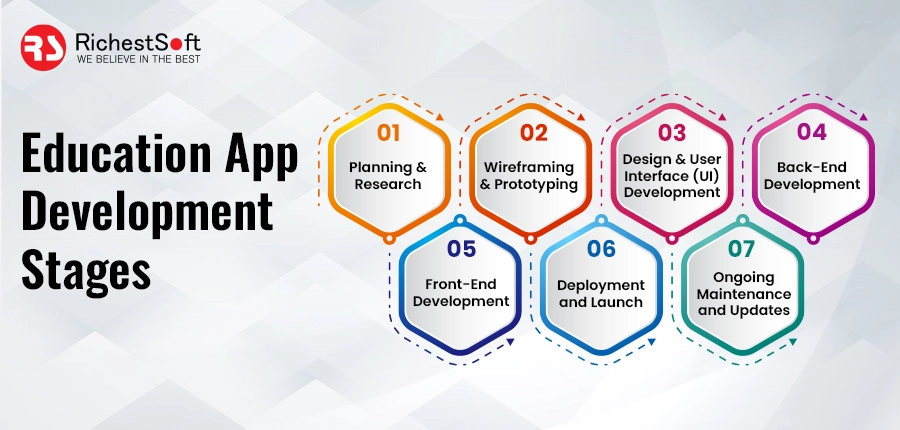
1. Planning and Research:
Begin by defining the objectives of your education app. Identify the target audience, their needs, and the specific problem your app aims to solve. Conduct market research to understand the competition and gain insights into user expectations. Outline the app’s features, functionalities, and user interface design.
2. Wireframing and Prototyping:
Create wireframes to visualize the app’s layout and navigation. Wireframing helps you structure the app’s content and define user interactions. After completing the wireframes, create interactive prototypes to test the app’s usability and collect user feedback.
3. Design and User Interface (UI) Development:
Design an appealing and user-friendly interface for your education app, evaluating the target audience and the app’s purpose. Ensure consistent branding, intuitive navigation, and visually appealing graphics for a seamless user experience. Prioritize accessibility, making the app inclusive and accessible to users with disabilities.
4. Back-End Development:
Build a robust back-end infrastructure for your education app, encompassing servers, databases, and APIs. Enable seamless data flow and integration of external services while prioritizing security to safeguard user data. Create a scalable architecture for a reliable and efficient app experience.
5. Front-End Development:
Craft the front-end elements of your education app, comprising the user interface and interactive components. Use cutting-edge web technologies like HTML, CSS, and JavaScript to create interfaces that are responsive and user-friendly. Enhance learning by adding interactive elements like movies, tests, and progress-tracking tools.
6. Deployment and Launch:
Prepare your education app for deployment by packaging and optimizing it for distribution. Publish the education app on relevant app stores like Google Play Store or Apple App Store. Promote your education app through marketing efforts to reach your target audience effectively. Continuously monitor user feedback and make updates based on user needs and app performance.
7. Ongoing Maintenance and Updates:
Once your education app is launched, the journey doesn’t end there. Continuously monitor and maintain the app to ensure its smooth operation. Gather user feedback and address any issues or feature requests promptly. Regularly update the app with new features, improvements, and security patches to keep it relevant and up-to-date.
Integration of Interactive Features
In the modern world, education has evolved beyond traditional classroom settings thanks to integrating interactive features in education apps. These interactive features breathe life into learning materials, making education engaging, immersive, and compelling. Here, we will explore the significance of integrating interactive features in education apps and how they enhance students’ learning experiences. Whether you’re a beginner in mobile app development or an educator interested in leveraging technology, understanding the power of interactive features is essential.
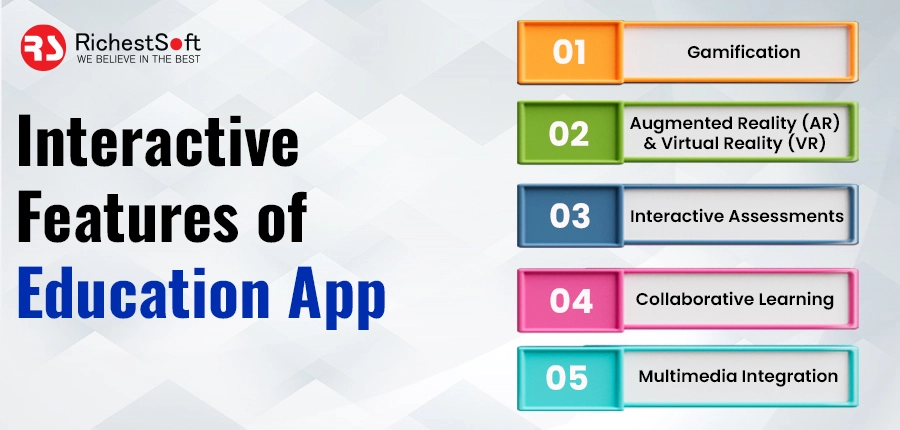
1. Gamification:
One of the most popular interactive features in education apps is gamification. By incorporating game elements such as challenges, rewards, and leaderboards, apps can transform learning into an enjoyable experience. Gamification motivates students to participate actively, encourages healthy competition, and provides instant feedback on their progress. Whether solving quizzes, completing tasks, or unlocking achievements, gamification fosters engagement and enhances knowledge retention.
2. Augmented Reality (AR) & Virtual Reality (VR):
Immersive technologies like VR and AR have revolutionized education by transporting students to virtual or augmented worlds. By integrating these features into education apps, learners can explore historical sites, dive into scientific simulations, or manipulate 3D models. VR and AR provide a hands-on, experiential learning environment, fostering more profound understanding and critical thinking. These interactive features enhance engagement and create memorable learning experiences beyond traditional textbooks.
3. Interactive Assessments:
Assessments play a vital role in gauging students’ understanding and progress. Education apps can elevate traditional evaluation by incorporating interactive elements. Instead of monotonous multiple-choice questions, interactive assessments may include drag-and-drop exercises, matching games, or interactive simulations. Such interactive reviews offer immediate feedback, adaptive learning paths, and personalized recommendations, enabling students to learn independently and address individual learning needs.
4. Collaborative Learning:
Collaboration is an essential aspect of education. Education apps can facilitate collaborative learning by integrating features that allow students to interact and work together. Discussion boards, chat functionalities, and collaborative projects promote knowledge sharing, peer-to-peer feedback, and teamwork. By fostering collaboration, education apps create a sense of community, encourage active participation, and enhance social learning experiences.
5. Multimedia Integration:
Text-heavy learning materials can become monotonous and fail to engage learners effectively. Education apps can integrate multimedia elements such as videos, audio clips, and interactive presentations to enhance content delivery. Visuals, animations, and interactive infographics make complex concepts easier to understand, catering to different learning styles. Multimedia integration promotes active learning and helps students grasp concepts more effectively by appealing to multiple senses.
Testing and Quality Assurance
In-app creation, perfection, and error-free experiences are crucial, especially for Education app development. Testing and quality assurance are necessary to guarantee the mobile app works well, fulfills user expectations, and provides a good learning environment. Here, we’ll look at the importance of testing and quality standards in developing educational apps and how those elements affect how well they work.
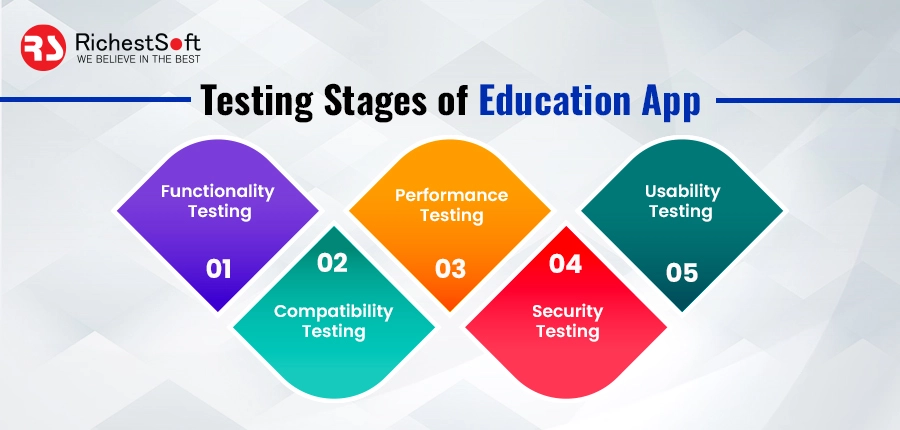
1. Functionality Testing:
Functionality testing is prime to confirm that all features and functionalities of the education app work as planned. It involves checking every aspect of the education app, from navigation to user interactions, to confirm a seamless user experience. By conducting strict functionality testing, developers can identify and fix any problems or bugs that may hinder the education app’s performance, guaranteeing a smooth learning journey for users.
2. Compatibility Testing:
Education apps are accessed by users across different devices, operating systems, and screen sizes. Compatibility testing confirms that the Education app works seamlessly across different platforms and devices. It contains testing the Education app on other browsers, mobile devices, and operating systems to identify and rectify compatibility problems. By conducting thorough compatibility testing, developers can guarantee that the Education app reaches a broader audience and provides a consistent user experience.
3. Performance Testing:
Performance testing considers the Education app’s speed, responsiveness, and stability. It involves testing the Education app under various conditions, such as high user traffic or low network connectivity, to assess its performance. By executing performance testing, app developers can optimize the Education app’s performance, enhance loading times, and confirm it can handle user demands effectively, providing a smooth and uninterrupted learning experience.
4. Security Testing:
When it comes to education apps, security is of the highest importance. Security testing involves considering the Education app’s susceptibility to threats like data violations or unauthorized access. It contains conducting penetration testing, analyzing encryption protocols, and assuring compliance with data protection regulations. By executing, developers can protect user data, robust security measures, maintain user trust, and provide a secure environment for learning.
5. Usability Testing:
Usability testing considers the education app’s user interface (UI) and user experience (UX). It involves collecting user feedback to assess the education app’s ease of use, navigation, and overall user satisfaction. Usability testing helps identify usability problems or areas for improvement, allowing developers to make essential adjustments to improve the user experience. By prioritizing usability testing, developers can create intuitive and user-friendly education apps that resonate with learners of all levels.
App Launch and Marketing
Creating an education app is a significant achievement, but the journey continues. The success of your app depends not only on its development but also on how effectively you launch and market it to your target audience. Here will explore the crucial aspects of app launch and marketing strategies specifically tailored for education apps. Whether you’re a beginner in the app development industry or an educator venturing into the world of technology, this blog will provide insights and guidance on launching and marketing your education app effectively.
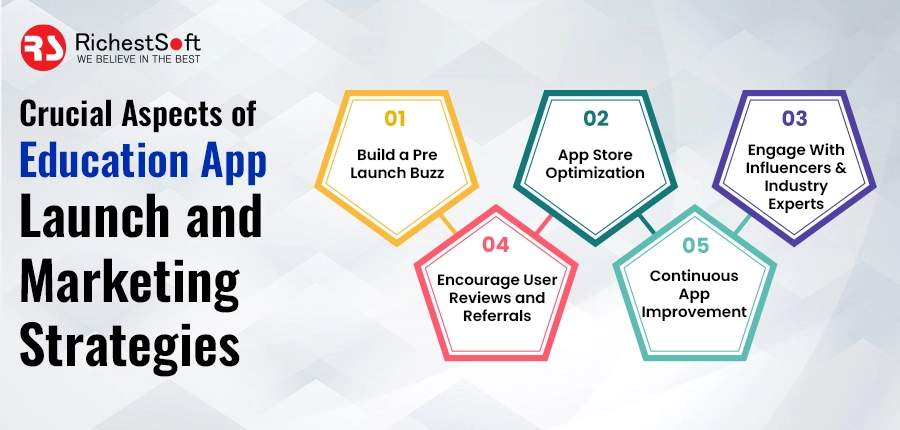
1. Build a Pre-Launch Buzz:
Creating anticipation and excitement around your app is crucial to generate interest before the official launch. Start creating a pre-launch buzz by leveraging social media platforms, making teaser videos, and offering exclusive sneak peeks to engage your audience. Enable users to sign up for updates and notifications to stay interconnected with your mobile app’s progress and be the first to know about its release.
2. App Store Optimization (ASO):
App Store Optimization is optimizing your mobile app’s visibility in the app stores, such as Google Play Store and Apple App Store. Perform thorough keyword research and possess relevant keywords in your mobile app’s title, description, and tags. Craft compelling and informative app descriptions that highlight its unique features and advantages. Optimizing your app’s visuals, including screenshots and mobile app icons, also plays a crucial role in attracting potential users.
3. Engage with Influencers and Industry Experts:
Collaborating with educational influencers and industry experts can significantly impact your app’s reach and credibility. Find influential educators, bloggers, or social media personalities who align with your app’s purpose and values. Partnering with them can help you tap into their established audience, gain valuable endorsements, and increase brand awareness.
4. Encourage User Reviews and Referrals:
Positive reviews and word-of-mouth referrals are dynamic tools for app marketing. Encourage your users to leave reviews and ratings on app stores. You can also implement referral programs that reward users for recommending your app to others. Positive user experiences and testimonials will build trust and attract new users to explore and download your education app.
5. Continuous App Improvement:
Launching your app is just the beginning. Regularly update your app based on user feedback and evolving educational needs. Engage with your users through in-app surveys or feedback forms to understand their experiences and areas for improvement. You can retain and attract existing users by consistently enhancing your app’s features, functionality, and content.
Cost of Developing Educational Apps
The cost of making an educational app can be challenging to estimate because it depends on the number of features, including the educational app’s complexity, required features, platform compatibility, the app development team’s location, and the rates of the app development team. Based on industry standards, I can give you a general price range instead:
1. Basic Educational App: $5,000 – $20,000
It includes a simple app with core features like content delivery, quizzes, and fundamental user interactions. It typically targets a single platform (either iOS or Android).
2. Medium Complexity Educational App: $20,000 – $50,000
It contains more advanced features such as interactive lessons, multimedia content, progress tracking, user profiles, and integration with third-party APIs. It may target multiple platforms.
3. Advanced Educational App: $50,000 and above
It includes highly complex apps with features like augmented reality (AR), virtual reality (VR), gamification, machine learning, personalized learning paths, social interactions, and integration with learning management systems (LMS). These apps often require extensive customization and can target multiple platforms.
FAQs
Q1: What are the main steps involved in creating an education app?
Ans: To develop an education app successfully, it is essential to:
- Identify the target audience and their needs.
- Define objectives and features.
- Design a seamless user experience.
- Leverage suitable frameworks and technology.
- Conduct thorough quality assurance testing.
- Finally, publish and promote the app effectively.
Q2: How long does it take to build an education mobile app?
Ans: The development time for an education app differs based on factors like complexity, advanced features, and available resources. Developing an educational app from start to completion can take six months to years.
Q3: How can I monetize my education app?
Ans: Several monetization options exist for education apps, including subscriptions, advertisements, in-app purchases, partnerships with educational institutions or content providers, and delivering premium content or features. It is essential to evaluate the target audience and their willingness to pay for the value provided by your education app.
Q4: How can I gather user feedback and improve my education app?
Ans: User feedback is paramount for app improvement. You can integrate feedback mechanisms within the education app, such as ratings, reviews, and feedback forms. Also, you can examine user behavior through google analytics tools to gain insights into user preferences and identify areas for advancement.
Conclusion
Building an education app can be a rewarding endeavor that empowers learners and facilitates the dissemination of understanding. By comprehending the target audience, defining clear objectives and features, leveraging appropriate technology, incorporating interactive features, conducting thorough testing and quality assurance, and implementing a strategic education app launch and marketing plan, you can set yourself up for success in the competitive landscape of educational apps.
Remember that building an education app requires careful planning, continuous learning, and adaptability. It is paramount to stay updated with the latest trends and technologies in the education and app development industry to give a seamless user experience.
As you embark on this exciting venture, keep the student at the center of your education app development. Evaluate their requirements, preferences, and learning styles to create an engaging learning environment. And remember the importance of feedback and continuous advancement to refine your education app over time.
By following the suggestion given in this guide and being dedicated to the continuous growth of your education app, you can significantly contribute to the area of education and give students a helpful tool to acquire knowledge and talents.
So, what are you waiting for? Let your imagination and passion for education glow as you undertake the journey to build an education app that can change how people learn and grow. Good luck on your Education app development journey!
 +1 315 210 4488
+1 315 210 4488 +91 798 618 8377
+91 798 618 8377